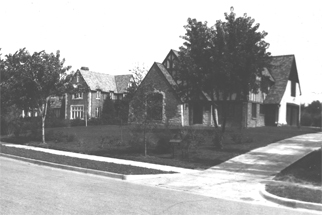Archives
Music of Old Nebraska
- Wednesday, 28 January 2015 16:45
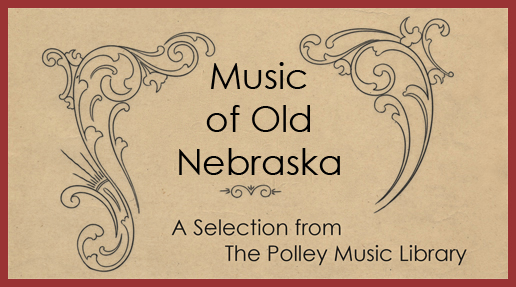 A Selection from the Polley Music Library
A Selection from the Polley Music Library
Introduction
Music has always played a part in the lives of Nebraskans, as it has for all humanity. This project was designed to share some of the Nebraska-made music that was written in the late nineteenth and early twentieth centuries. The vehicle for this sharing is a selection of sheet music that currently resides in the Polley Music Library in Lincoln. These pieces represent a broad sampling of the output of Nebraska musicians who range from out-and-out amateurs to professional teachers, performers, and composers. As such, the quality of the pieces varies widely, but all of them share the common thread of their Nebraska provenance. Polley Music Library has over 8600 pieces of sheet music in its collection. They came from the personal collection of Lillian Helms Polley and from years of so-called “piano bench” donations. We chose 110 representative pieces in which the music and/or the lyrics were written by Nebraskans (or, in a few cases, were written about famous individuals in Nebraska history).
We entitled our project “Music of Old Nebraska”. Unlike many other online digitized sheet music projects, our aim has been to set the music in an historical context rather than just providing a catalog of the pieces, though that is present also. We created archival scans of all the music, cleaned them up using Photoshop CS, and converted them to Adobe PDF form. All of the pieces were published before 1923 and are in public domain. You may freely download, print, and perform any of them, and we hope you will do so!
This project is supported in part by the Institute of Museum and Library Services under the provisions of the Library Services and Technology Act as administered by the Nebraska Library Commission. Additional funding has been provided by the Lincoln City Libraries, and the Swanson Biggs Adams Family Foundation donated funds for the writing of the lesson plans. We are extremely grateful to all of these organizations for making our project possible.
Catalogs
Titles
Authors (annotated)
Pieces by Subjects
Thumbnails
Sound Files
It is possible to search our Music of Old Nebraska collection in several ways.The Titles, Authors, and Songs by Subjects catalogs are text only.The Authors catalog is annotated with biographical information about the composers.
Clicking on an item in a catalog will take you to a metadata page for that piece. There you will find publication information and links to free downloads of the sheet music.
Polley Music Links
- Monday, 27 October 2014 22:45
We want this page to be as useful as possible to you. Please let us know if there are any changes we can make to this page that would help you. For now, we have included only those web sites and pages that have been of most benefit to the Polley Music staff as we help customers answer reference questions. At the present time, we are not able to accept suggestions for new links on this page. If you discover a broken link on this page, please let us know by e-mailing us at polley@lincoln.ne.gov. Please note: Polley Music Library does not control or endorse the contents of any of these sites.
Alternative | Basics of Music | Bluegrass/Old Time | Blues | Censorship and Music | Charts | Classical Music | Competitions | Country Western | Early Music | Electronic/Computer | Ethnomusicology | Experimental | Film, TV, and Radio | Folk Music | Grants for Musicians | Holiday Music | Instruments | Jazz | Jobs for Musicians | Lyrics | Multi-topic | Music and Health | Music Education | Music Links for Kids | Musicals | New Age | Online Radio | Opera | Patriotic Music | Pop/Easy Listening | Publishing/Copyright | Punk | Rap/Hip Hop | Recorded Music | R&B/Soul | Rock | Sacred Music | Salsa | Sheet Music | Sound Effects | Sports/Dance | Swing/ Big Band | Techno | Video Game Music | Wedding Music | Women’s Music | World Music
ALTERNATIVE
BASICS OF MUSIC
MusicNovatory (http://www.musicnovatory.com not active)
Instrument Transpositions
Music Theory & History Online
Musical Instrument Ranges & Names
Music Dictionary Online
Music Fundamentals
Animated Music Theory Lessons
Online Ear Training Lessons
Music Notation Reference Guide
Basic Music Theory
Center for the History of Music Theory and Literature
Free Printable Staff Paper
Introduction to Reading Music
Basic Theory
BLUEGRASS/OLD TIME
International Bluegrass Music Association
Great Plains Bluegrass & Old-Time Music Association (site http://gpbotma.org/ appears to be offline)
Old-Time (Oldtimey) Music: What is it?
Banjo Tablatures and Bluegrass Information
Bluegrass Country
BLUES
CENSORSHIP AND MUSIC
Freemuse
Music Censorship in Australia
CHARTS
Alaska Jim’s Music Charts
Top Hits Online
Charts All Over the World
World Music Charts Europe
CLASSICAL MUSIC
General Links
Classical Net
Naxos Classical
The Classical Music Navigator
Classical Music Directory
IMSLP/Petrucci Music Library
Composers and Performers
COMPETITIONS
World Federation of International Music Competitions
Music Competitions, contests
COUNTRY WESTERN
Country Stars (http://www.countrystars.com not active)
Country Western Song Machine
About Country Music
The Soflin Sisters
EARLY MUSIC
Prehistoric and Ancient Music (many cultures) See also: World Music or Instruments
Music in Ancient Times
The Kithara in Ancient Greece
Ancient Musical Instruments of India
Medieval and Renaissance Music (mostly European culture)
The Reconstruction of Azerbaijan’s Medieval Instruments
Early Music FAQ
Arto Wikla’s Early Music
The Cantigas de Santa Maria
Early Instrument Resources
The Serpent Website
SCA Medieval and Renaissance Music Homepage
A Guide to Medieval and Renaissance Instruments
Early Music Online
ELECTRONIC/COMPUTER (see also: Experimental)
General Information and Links
OHM – The Early Gurus of Electronic Music
120 Years Of Electronic Music
Computer Music Consulting
The Acoustical Society of America
Copyright Primer on Computer Music Files
The History of Electronic Music (site http://www.phinnweb.org/history/ not available as of September 2020)
Synth Zone
Soundart: Circuit Bending
Sound Synthesis
Sound Synthesis
Sound Synthesis – Handbook for Acoustic Ecology
Music Software
JSyn Software
Cubase Links
SynthEdit Links
Virtual Synth Page
MuseScore
Music Hardware
Vintage Synth Explorer
Analogue Synths
Synthmuseum
MIDI/MP3/Music Downloads/Loops
MIDI Database
MIDI Manufacturers Association
SoundClick
Music Notation Programs
Music Notation Links
Sibelius Software Resources
PLUM – Programming Languages Used for Music
Sound Files/Samples/Loops/Plugins
Drum Track Zone
Looper’s Delight
Free WAV Samples
Free Sounds and Music
Free Sound Effects
Partners in Rhyme
Online Electronic Music Magazines
Computer Music
Future Music (http://www.futuremusic.co.uk/ appears to be inactive)
Music Tech Magazine
Electronic Musician Online
Keyboard Magazine
Mix Magazine
ETHNOMUSICOLOGY
International Council for Traditional Music
Ethnomusicology in SIL
EXPERIMENTAL (see also: Electronic/Computer)
Miniorgans
Odd Sounds
Intuitive Music
Experimental Music
Disquiet – Ambient/ Electronica
Sleepbot.com
Ambience for the Masses
The Livingroom.org – forum for experimental music
Oddmusic
The Center for Experimental Music and Intermedia
JEMS: The Journal of Experimental Music Studies
Buzz Kimball: Nonoctave.com
FILM, TV, and RADIO
(See also: Musicals)
The Film Music Society
Hindi Film Music
Name the Tune in That Show
Film Music Society Resources and Links
Film Music Magazine
Film Score Monthly
Margaret Herrick Library Digital Collections (Academy of Motion Picture Arts and Sciences)
Television Tunes
FOLK MUSIC
(See also: World Music)
Folkmusic.org
Northern California
Folk Music from the Thirties
Folk Music of Britain, Ireland & America
FolkLib Index
Malvina Reynolds: Song Lyrics and Poems
The 111 Greatest (Anglo-American) Folk Music Artists
Traditional Music Library
GRANTS FOR MUSICIANS
National Endowment for the Humanities
National Endowment for the Arts
HOLIDAY MUSIC
INSTRUMENTS
Individual Instrument Links
You can use this alphabetized list to access information about individual musical instruments. There may be additional information about the instrument in other sections of this links page. You might also try under Early Music, Electronic/Computer, Multi-topic, Sheet Music, and, in particular, World Music if you know in what part of the world the instrument is played. You might find information in this Instruments section in the General Links, Physics of Musical Instruments, Instrument Building and Experimental Instruments, and Miscellaneous Links.
A B C D E F G H I J K L M N O P Q R S T U V W X Y Z
Accordion/Concertina
Accumulated Accordion Annotations
Accordion Links Homepage
Accordions Worldwide
Alphorn
Alphorn – The Sound of Natural Tones
Archlute
Chitarrone, theorbo and Archlute
Autoharp
The Autoharp Page
The Internet Autoharp Page
Amplifying your Autoharp
Bagpipe (see also: Gaida, Uillean Pipes)
Bagpipes of the World
Seth Gallagher Workshop: Irish Uilleann Bagpipes
Swedish Bagpipes
Banjo
5-String Banjo
Banjo Hangout
ezFolk Clawhammer Banjo (site http://www.ezfolk.com/banjo/ not currently available)
Beginners Banjo Lessons
Jim Bottorff’s Banjo Page
The Classic Banjo Resource
Baritone/Euphonium
Baritone or Euphonium?
Bass (see: Double Bass or Electric Bass)
Bassoon
Fingering Charts
Bassoon Family Fingering Companion
Bassoon Fingering Chart
Berimbau (see: Musical Bow)
Bodhran
The Bodhran Page
Bouzouki
A Crash Course on Lutes – Bouzouki
Carillon
About Carillons
Cello
The Joy Of Cello Playing
Internet Cello Society
Charango
Charango Organization (no longer available)
The Charango
Clarinet
Fingering Charts
The International Clarinet Association
The Clarinet Pages
History of the Clarinet
Concertina (see: Accordion/Concertina)
Cornet (see: Trumpet/Cornet)
D
Djembe
Djembefola (site http://www.djembefola.com appears to be inactive)
Doumbek
A Quick and Dirty Guide to the Doumbek
Middle Eastern Rhythms
Drums and Percussion (see also: names of individual percussion instruments)
Drum – Background, History, Raw Materials, Manufacturing
Listen to and learn about drums of the world
A Drum Lessons Database
African Polyrhythms
Middle Eastern Percussion Resources (site http://www.maya.com/local/senn/drum.html appears to be inactive)
The Percussion Book
Drum Score Archive
Rudimental Drumming
Bongo Mania
The Hip Rhythm Digest
Drum Dojo (site http://www.drumdojo.com appears to be inactive)
Algorhythm
World Beats
Dulcimer
Appalachian Dulcimer
Electric Bass
Online Bass Lessons
The Bass Player Garage
CyberfretBass – free online electric bass lessons
Bassmasta Tabs
English Horn (see: Oboe/English Horn)
Euphonium (see: Baritone/Euphonium)
Flute/Piccolo
Fingering Charts
A Guide to the Irish Flute
History of the Flute
Flute History
Flute History.com (site flutehistory.com appears to be temporarily inactive)
Mark Shepard’s Flute Page
The Virtual Flute
Frame Drum
Frame Drums and Tambourines
Framedrums: bendir, deff and tar (site: http://www.belly-dance.org/bendir.html appears to be inactive)
French Horn
The French Horn
History of the French Horn
Glass Armonica (Glass Harmonica)
The Music and Magic of the Glass Armonica
“Dance of the Sugar Plum Fairy” on the Glass Armonica
Guitar (Electric and Acoustic)
The Classical Guitar Home Page
The Flamenco Guitar Home Page
Online Guitar Instruction
Classical Guitar Illustrated History
Basic Guitar Chords
Hammer Dulcimer
The Hammered Dulcimer
Harmonica
Harmonica, Blues Harp Links
Harp On! Chromatic Harmonica Reference
Harp (Folk and Pedal)
Harp Spectrum
Harp Guitars
Harp Guitars
7-String, 8-String, 9-String, & 10-String Guitars
Harpsichord
British Harpsichord Society
Hurdy Gurdy
Olympic Musical Instruments
The Hurdy Gurdy Explained
Irish Banjo (see: Banjo)
Irish Bouzouki (see: Bouzouki)
Irish Harp (see: Harp Folk and Pedal)
Jew’s harp
The Jew’s Harp Column
Kalimba (see: Thumb Piano)/strong>
Kantele
About the Kantele
Kavals
The Kaval
Kazoo
The Kazoo – Its “physics”, history and importance for modern music
Kemenche (Kemence)
Kemence
Khene (Khaen)
The Laotian Khaen
Lute
The Lute Society
Mandolin
Mandolin Cafe
Building a Mandolin
How to Tell Mandolins, Citterns, Mandolas, Bouzoukis etc. Apart
Mbira (see: Thumb piano)
Mechanical Instruments
About Automatic Music Instruments Generally
Musical Bow
Berimbau Page
Berimbau
Musical Saw
Musical Saw
Ney (Nay or Nai)
Ney, Nai (site: http://www.belly-dance.org/ney.html appears to be inactive)
Middle East Musical Instruments – Nay (Ney)
Nyckelharpa
American Nyckelharpa Association
Oboe/English Horn
Fingering Charts
Ocarina
The History of Ocarina di Budrio (in Italian)
Free sheet music for Ocarina
Organ
American Theatre Organ Society
Oud
Oud – Nikos Dimitriadis
Al ‘Ud – The Oud
Panpipes
History of the Panflute
Panpipes – Building and Playing
Penny Whistle (see: Tin Whistle)
Percussion (see: Drums and Percussion)
Piano
Chord House, Piano Room: Chords and Scales
History of the Piano (site http://www.uk-piano.org/history/history.html not currently available)
The Player Piano Page
Piccolo (see: Flute/Piccolo)
Pipe and Tabor
Pipe and Tabor
Quena
Quena at Pan-Flute
I Love Quena
Rebec
The Rebec Project
Recorder
Fingering the Recorder
Recorder Trills, Turned Trills, and Turns
Recorder Home Page
Sackbut (see: Trombone)
Santur
Santur
Sanza (see: Thumb piano)
Sarrusophone
Sarrusophone Fingering Charts
Sarrusophone
Saxophone
Fingering Charts
Saxophone Fingering Charts
Saxophone Resources on the Internet
The International Saxophone Home Page
History of the Saxophone
Sax on the Web
Shakuhachi
Shakuhachi Fingering Chart
Sho (see also: Sheng, Khene, Khaen)
The Japanese Sho
Sousaphone (see: Tuba/Sousaphone)
Steel Drums
Toucans Audio Clips
About the Steel Drum
Tanbur
Analysis and Physical Modeling of Tanbur
Theremin
Theremin Vox
Thumb Piano
N. Scott Robinson: Mbira article
Tin Whistle
Tin Whistle and Fife Fingering Charts
Mick’s Virtual Whistle
Tonbak
Peyman and his tonbak
Trombone
Trombone Page of the World
Online Trombone Journal
Trumpet/Cornet
Trumpet Guild
Uilleann Pipes
The Uilleann Pipes (page at http://www.taramusic.com/features/uilleann.htm no longer active)
Irish Uilleann Pipes Fingering Chart
Uilleann Penny-Chanters
Na Poibairi Uilleann
Uilleann Obsession
Ukelin
The Ukelin and Related Instruments
Ukulele
Ukulele Lesson
Viola da Gamba (Viol)
Viola da Gamba Society
Viola da Gamba
The Gamba
Violin
The Violin Society of America
General Information on Obtaining Authentication and Appraisal of Violins
Whistling
Whistling Lessons 101 by Whistling Tom (no longer available)
Xalam
Xalam
Yangchin (Yangqin)
Zils (see: Cymbal)
Zither
Fretless Zithers
General Musical Instrument Links
World Music Instrument Gallery
Contrabass Mania
Classical Free Reed Instruments
Musical Instruments Gallery – Oddmusic
A Guide to Medieval and Renaissance Instruments
Physics of Musical Instruments
Physics of Musical Instruments
Physics of Musical Instruments – A Brief History
Music Acoustics UNSW
Instrument Building and Experimental Instruments
Building a Guitar
My Homemade (and other) Odd Instruments
Build a Banjo
Building a Hurdy-Gurdy
Making a Clay Didjeridu
Experimental Musical Instruments (windworld.com – site no longer active)
Building a Mandolin
World and Experimental Musical Instrument Links
How to make your own water drum
Basic Xylophone Building
The Rebec Project – Making the Rebec
My homebrew pipe organ
Lutherie Info for Builders of Stringed Musical Instruments
Music Instrument Builders Resources (http://www.tinwhistles.us/experiem.htm – site no longer active)
Getting Started in Instrument Building
Recreating the Jorvik Viking Panpipes (http://www.panflutejedi.com/viking-pan-flute-tutorial.html – site no longer active)
Making Pan flutes
Here’s How to Make a Musical Bamboo Flute
The Musical Instrument Makers Forum
Building Mandolin No. 001
How to Make a Bodhran
Early Instrument Resources
Iner Souster and the Experimental Instruments He Lives With
Miscellaneous Links
The American Musical Instrument Society
Instrument Jokes
JAZZ
Chord Progression Lessons
JOBS FOR MUSICIANS
Music Careers: The Complete List
LYRICS
Lyrics Planet
Lyrics Freak
A – Z Lyrics Universe
Country Western Song Machine
Black Cat Rockin’ Lyrix Index (site http://www.rockabilly.nl/lyrics/lyrics.htm appears to be inactive as of May 2020)
Disney Song Lyrics
MULTI-TOPIC
General Links
This Day in Music History
Metropolis’ Online Pitch Pipe
Gaylord Music Library Musicians Necrology
All Music Guide
The Free Dictionary – Music
Music Theory for Songwriters
A Brief History of the Mechanical Metronome
Music and politics
The names of instruments and voices in foreign languages
University and Academy Library Links
Library of Congress – Performing Arts Reading Room
Genres/Artists/Groups
All Music Guide
MTV Online
Reviews
La Folia Online Music Reviews
MUSIC AND HEALTH
Health Issues of Performers
The Affliction of the Musician
Musician’s Health (site musicianshealth.com appears to be unavailable)
Proper Sitting Position when Playing the Cello
Vocal Health Links
Singers Health
Music Therapy
American Music Therapy Association
Music as Therapy: How Music Can Make You Healthier (site http://www.articlemyriad.com/music-therapy-music-healthier/ appears to be unavailable)
MUSIC EDUCATION
Music Teacher Resources: Online Music Lesson Plans
Karin’s ESL Partyland: Teaching With Music
Music Teachers National Association
National Association for Music Education (NAfME) (formerly (MENC)
Music Education at Datadragon
MUSICALS
Musicals 101
Musicals.Net (site http://musicals.net no longer active)
Reel Classics – Musicals
Original Rock Musicals
Musical Cast Album Database
NEW AGE
ONLINE RADIO
Oddio Overplay
Radio Tower (site http://www.radiotower.com no longer active)
Sleepbot Environmental Broadcast
Xfm – London’s New Music Radio Station
WCPE Classical Music, 24 Hours a Day
SHOUTcast
NPR
BBC Radio
Radio-Locator
KJIC Gospel Radio
OPERA
Opera Stuff
Opera Company Pages on the World Wide Web
Opera Glass
PATRIOTIC MUSIC
Directory of Patriotic Web Sites: Patriotic Music
The Fifties Web – Patriotic Songs
National Anthem Information
Music and Politics
POP/EASY LISTENING
Center for Popular Music
J D Hay’s Crooners Collection
PUBLISHING/COPYRIGHT
Composition/Publishing
American Society of Composers, Authors and Publishers
National Association of Composers, USA
Copyright Information
A Plain Guide to Copyright
Public Domain Music
Music Copyright Law Directory
Music and Copyright Law
United States Copyright Office
10 Big Myths About Copyright Explained
Copyright Primer on Computer Music Files
PUNK
Punk Music – A Brief History and Beyond
The Punk Page
RAP/HIP HOP
African HipHop
About Rap/Hip-Hop
Old School Hip Hop
History of Rap
RECORDED MUSIC
Centre for the History and Analysis of Recorded Music (now inactive at http://www.charm.rhul.ac.uk)
Canadian Antique Phonograph Society
Antique Phonograph Music Program
Early Recorded Sounds and Wax Cylinders
Dismuke’s Acoustical Recordings 1900 – 1925
Sound Recording
Tinfoil – Dedicated to the preservation of early recorded sounds
Internet Museum of Flexi/Cardboard/Oddity Record Links
Hollywood and Vine: Capitol Records
ROCK
Rock-and-Roll Page
Heavy Metal Music
Rock N Roll Reference Discography
Reason to Rock: Rock Music as Art Form
The History of Rock Music
Rock and Roll Hall of Fame and Museum
The History of Rock and Roll
Nebraska Music Hall of Fame
1960s British Rock
Mining Company – Classic Rock
Prog Archives
R&B/SOUL
Rhythm and Blues Foundation (http://www.rhythmnblues.org/ – not currently active)
About R & B Music
Rhythm and Blues Wikipedia
Doo Wop on the Soul-Patrol
Soul Music in Wikipedia
SACRED MUSIC
Sacred Music History (Christian)
Chant Links
Gospel
Gospel Music Archive – Tabs and Chords for Guitar
Negro Spirituals and Antique Gospel Music
Other Traditions
Fasola Home Page
Sacred Harp Singing
SALSA
Salsa & Merengue Society – Salsa: The Music
Just Salsa Magazine
Salsa Music
History of Salsa
SHEET MUSIC
Free printable sheet music for “Beautiful Nebraska”
Music of Old Nebraska free sheet music archive
Pipe and Tabor Sheet Music
American Sheet Music, 1870 – 1885
African-American Sheet Music, 1850 – 1920
The Lester S. Levy Collection of Sheet Music
Mutopia
Breizh Partitions: Free Celtic Music Scores
Drum Score Archive
Choral Public Domain Library
IMSLP/Petrucci Music Library
American Choral Music
SOUND EFFECTS
FindSounds – Search the Web for Sounds (www.findsounds.com temporarily unavailable)
TheFreeSite
The Recordist
Flashkit SoundFX
SPORTS/DANCE MUSIC
Multiple topic
Sport music: Music as ergogenic aid (no longer available)
Cheerleading Music
Cheerleading and Dance Music Mixes
Ballet and Modern Dance
The Ballet
CyberDance
Ballroom Dance
Ballroom Dance Steps
An American Ballroom Companion
Belly Dancing
Oriental Belly Dance
The Art of Middle Eastern Dance
Breakdancing
History of Breakdance
Court and Historic Dances
Court Dances
Basse Dance
Orchesography (digitized translation)
Renaissance Dance
Disco
Seventies Dance Music
The Disco History Page
DanceNetRadio (security software identifies DanceNetRadio.com as being a potentially problematic site)
Folk Dancing
Folk Dance History
Webfeet: Dancing on the Web
Hula
Hawaiian Music and Hula Archives
Hula Preservation Society
Line Dancing
Country and Western Dancing
Merengue
Merengue History of Dance
A History of Merengue
Multiple Dance Types
Dance Steps
D.J. Rhythms Dance Music Database
Dance Instruction Manuals
A comprehensive guide to dance websites from around the world
Polka
Polka Steps
Polka History
Polka: Wisconsin’s State Dance
Swing Dances
Jitterbug/Swing Dancing
Tango
Guides to Tango Music for Social Dancing
Tap
Tap Dance Homepage
Tap Dance – Basic Steps and Moves
Tap Dance History
SWING/BIG BAND
Swingin’ Down the Lane
Craig’s Big Bands and Big Names
TECHNO
Techno Music and Raves FAQ
Shoutcast
VIDEO GAME MUSIC
Videogame Music Archive
A History of Video Game Music
Video Game Music Albums (site http://www.gamealbums.com/ appears to be offline)
Overclocked Remix
A Game Music Index
Kohina
Ifurita’s Anime Jukebox
How video game music is created
Video Game Jam – Guitar and Bass Tablature for Video Game Music
Video Game MIDI Music
WEDDING MUSIC
WOMEN’S MUSIC
Diana Ambache on Women Composers
Women Composers Database
IAWM
Women’s Music
What Women’s Music Does, or Doesn’t Mean
Suffrage Singalong!
WORLD MUSIC
General Links
Inside World Music
Global Jukebox
World Music Central
World Music Instrument Gallery
Global Rhythm
National Public Radio Music: World
World Music Network
Africa: An Overview (For North Africa see: Middle East)
The African Music Encyclopedia
Afropop Worldwide
African Music and Drumming Resources on the Web
African Music Hub (site http://www.africanmusichub.com/ appears to be inactive)
The Manding Music Traditions of West Africa
Southern African Music Bibliographies
Asia: An Overview (For Central Asia see: Middle East)
Southeast Asian Traditional Music
Europe: An Overview
Regions:
Northern Europe
Kantele
Eastern Europe
The Balkans
Balkanarama
Latin America: An Overview
Andean Music Links
Music from the Andes
Cultures of the Andes – Quechua Songs
Caribbean Art and Music
Reggae Music
Middle East
Maqam Music
Maqam World
Turath Traditional Arab Music
Al Mashriq – Middle East Music (site http://almashriq.hiof.no/base/music.html appears to be inactive)
The Sahara: Music
Arab Music Websites
Music in Uzbekistan & Tajikistan
North America: see United States and Canada under Individual Country Links
Transnational Ethnic Groups
Assyrians
Songs of Assyria
MUSIC LINKS FOR KIDS
A Note to Parents: These links have been checked very carefully to be sure they are suitable for children. Polley Music Library cannot, however, guarantee that they will stay that way or that you will find them useful or appropriate for your own children. The safest solution always regarding the Internet is to personally supervise your children when they are online. We hope you can find enjoyable sites here! Please contact us with comments, ideas, and suggestions for other links you like.
Music Education at Datadragon
Children’s Music Games by Morton Subotnick: Creating Music
Arts Alive: Music
Children’s Music Web
Classics for Kids
Learn About Instruments
Mama Lisa’s World: Children’s Songs and Nursery Rhymes
Music Genre Sampler
Music in and Around Lincoln
- Thursday, 23 October 2014 15:07
The links on this page will take you to the Web pages of local musical groups and events. If you are interested in being listed here, please submit your Web page for possible inclusion. We want to provide as much information as we can about the music and musicians of Lincoln. You can e-mail us at polley@lincoln.ne.gov; be sure to include your URL.
Arts Councils and Associations
Concert Venues, Sponsors and Events
Professional Groups
Community Groups
Sponsors/Societies
Arts Councils and Associations
Lincoln Arts Council
Nebraska Arts Council
Nebraska Humanities Council
Nebraska Composer’s Alliance
Lincoln Music Teachers Association
American Federation of Musicians, Local 463
Nebraska Music Teachers Association
Nebraska Music Educators Association
Lincoln Friends of Chamber Music
Concert Venues, Sponsors and Events
Nebraska Public Radio
Lied Center for Performing Arts
Zoo Bar
Pinnacle Bank Arena
Pinewood Bowl
Rococo Theatre
Hixson-Lied College of Fine and Performing Arts
Nebraska Wesleyan Department of Music
Glenn Korff School of Music
Duffy’s Tavern
Knickerbockers (http://www.knickerbockers.net/ no longer active – still on Facebook)
Doane College Music
Concordia University School of Fine Arts
Abendmusik Lincoln
Berman Music Foundation
Lincoln Association for Traditional Arts
Lincoln Organ Showcase
Meadowlark Music Festival
Angels Theatre Company
Blues Society of Omaha
Great Plains Bluegrass and Old-Time Music Association
Professional Groups
Keelan Music
The New Music Agency
Lincoln Symphony Orchestra
Omaha Symphony Orchestra
Nebraska Chamber Players
Community Groups
Lincoln Homeschool String Orchestras
Lincolnaire Chorus, Inc./ Sweet Adelines
The Lincoln Continentals
First-Plymouth Congregational Church Music Department Programs
Contra Dances Lincoln Nebraska
Lincoln Community Playhouse
Lincoln Choral Artists
Lincoln Civic Orchestra
Lincoln Lutheran Choir
Lincoln Youth Symphony
Lincoln Boys Choir
Lillian Helms Polley and the Music of Lincoln
- Wednesday, 10 September 2014 20:22
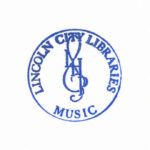 This brief account of the life and career of Lillian Helms Polley was gleaned from the archive of her materials that is housed in the Polley Music Library in Lincoln, Nebraska. The many programs, personal notes and memorabilia, manuscripts, letters, newspaper articles, reviews, and photographs in the archive collectively serve to draw a portrait of a woman who was central to the musical life of Lincoln during most of the twentieth century. Indeed, her gift to the city of a public music library keeps her spirit alive even into the current century.
This brief account of the life and career of Lillian Helms Polley was gleaned from the archive of her materials that is housed in the Polley Music Library in Lincoln, Nebraska. The many programs, personal notes and memorabilia, manuscripts, letters, newspaper articles, reviews, and photographs in the archive collectively serve to draw a portrait of a woman who was central to the musical life of Lincoln during most of the twentieth century. Indeed, her gift to the city of a public music library keeps her spirit alive even into the current century.
Many of the historical items were digitized so as to make them available online for public perusal. Some of those files are included in this page. Over 200 items appear in the Polley Music Library section of the Nebraska Library Commission’s “Nebraska Memories” page.
This Polley Music project was supported in part by the Institute of Museum and Library Services and Technology Act as administered by the Nebraska Library Commission. Additional funding was provided by the Lincoln City Libraries. We are extremely grateful to both of these organizations for making this presentation possible.
Lillian speaks:
“Music has been my life; it’s all I know. I can’t remember not reading music anymore than I can recall not being able to read words. I love Lincoln; it’s been my home since I was a baby and will be until I check out at Wyuka. I am a part of Lincoln’s history just as Lincoln has been part of my life.” (Lincoln Journal Star, July 6, 1971)
And again:
“Nothing has ever come into my life that could take music out of my life. Other things disappeared – didn’t stay – but music remained. I had to stay with music.” (Lincoln City Libraries Inter-Department Communication , September 21, 1966)
In these two quotes we have the essence of Lillian Helms Polley – the woman, the musician, the teacher, and the giver of an invaluable resource to the city of Lincoln.
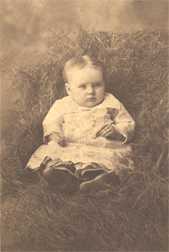 This charming, serious little girl was born Lillian Dobbs, May 18, 1881, in Creston, Iowa. She was the daughter of Edward O’Hail Dobbs and Cora Belle Henkle. On the first page of her personal scrapbook she preserved a genealogy which traces her familial roots back to Ireland.
This charming, serious little girl was born Lillian Dobbs, May 18, 1881, in Creston, Iowa. She was the daughter of Edward O’Hail Dobbs and Cora Belle Henkle. On the first page of her personal scrapbook she preserved a genealogy which traces her familial roots back to Ireland.
Her father, an investment banker, died of tick fever when Lillian was just an infant. In order to help out her struggling mother, Lillian’s uncle, Elmer Henkle, (of Henkle and Joyce Hardware Company in Lincoln) brought the baby to her grandmother, Candace Cargill Henkle, who lived in Lincoln. Candace and the young child were “inseparable”, and Lillian believed any success which came to her should be credited to her grandmother.
Lillian’s first public appearance, vaguely remembered, was at the opening of the Herpolsheimer building in Lincoln. It was a major social event celebrated with a ball and a grand march. She was a very small girl marching proudly at the end of the parade as the Tar Bucket. It had been “tenderly explained” to her by her uncle how important the tar bucket was to the covered wagon trains. She was four years old.
In the late 1880s the Henkle home at 11th and C Streets was convenient for school at Capitol Elementary and music lessons at the Nebraska Conservatory of Music at 13th and L Streets. She began her piano lessons at the age of six. She was very small, and could not reach the pedals on the piano, but she played for church socials anyway.
“I take lessons at the Nebraska Conservatory. Mr. Hadley makes me practice two hours a day and my hands are so small I always have to clean the lamp chimneys.“
After she grew a bit, so also did her repertoire, as seen in this program.
She rode her bicycle to Havelock, carefully avoiding the street cars, to teach piano and organ lessons for 25 cents a lesson.
“The neighbor children were pleased to have a little help counting time.“
She used the garnered quarters to pay for piano lessons with Professor Hadley at the Conservatory. She also accompanied for Clemens Movius’ voice students and used that money to pay for voice lessons with him. At the same time she studied Harmony with Lucy Haywood. From all accounts, she was a very fine young student, as can be seen in these 1890s reviews from the Nebraska State Journal.
Lillian continued her music studies while she attended Lincoln High School. While she was there she was given permission to study French and German at the University of Nebraska; this served her well in her later vocal career. She graduated in piano from the Nebraska Conservatory of Music in 1896. She was fifteen years old.
From 1897 to 1899 Lillian was an accompanist and voice coach in the Voice Department of the Conservatory. Some of Lincoln’s outstanding musicians of the time began to take notice of her.
“Carrie Belle Raymond encourages me. She knows so much and is so helpful.“
She was also leading a busy life as a recitalist and church soloist.
“I registered at the University in 1900. I tried to carry a full schedule but I’m singing at St. Paul’s Church and Matinee Musical and playing for Mr. Movius and studying with him.“
Lillian had hoped to graduate from the University in 1905, but music made many interruptions in her academic schedule. She was invited by her aunt in Chicago for visits so she could hear fine music. She was in high demand as a performer at many local venues including the ProCathedral, St. Paul’s Methodist Church, Trinity Methodist Church, Wesleyan University, First Presbyterian Church, the Unitarian Church, the Jewish Synagogue, and the First Church of Christ Scientist. Like many musicians, she performed at various religious institutions without regard to their affiliations. It was the music that was important.
She was always described as a charming performer with a particularly pleasing stage presence. This contemporary newspaper account of an incident during a concert serves to illustrate her public persona:
“The value of quick wit and a sense of the humorous in saving the situation was illustrated at a recent musicale during the singing of a dainty lullaby. The vocalist [i.e., Lillian] had artistically modulated her voice until her audience felt that the cradle was about to stop, when an awful commotion suddenly arose at the door in the arrival of some late comers, who were not aware that a program was in progress. Everybody looked at the singer, who was obliged to stop, but instead of showing signs of irritation she laughed spontaneously and said quickly, “I hope the baby won’t wake.” As soon as the fresh guests were seated she began the song over again and sang without loss of effectiveness.“
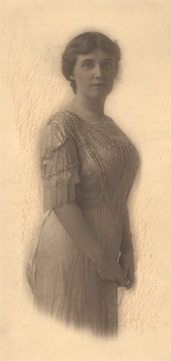 Everywhere Lillian performed she was received with great enthusiasm. All of the reviews emphasize the beauty and clarity of her voice as well as her personal charm. She was quite a lovely young woman, with the red hair and blue eyes indicative of her Irish heritage; she stood just over five feet tall.
Everywhere Lillian performed she was received with great enthusiasm. All of the reviews emphasize the beauty and clarity of her voice as well as her personal charm. She was quite a lovely young woman, with the red hair and blue eyes indicative of her Irish heritage; she stood just over five feet tall.
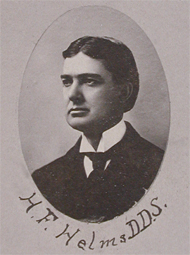
Photo courtesy of the College of Dentistry, UNL
In 1902 an additional interruption to her career occurred. She met young H. Finley Helms, a popular young dentist and teacher on the faculty of the University Dental College who also had a private practice located in the Burr Block on O Street. They became “enamored” and were married on December 17, 1902.
“We are building a new home on north 24th Street, and there is little time for singing.“
Sadly, their life together was to be very short. Helms died suddenly in their new home on July 31, 1905. In the typical fashion of newspapers of the day, the death was described in great detail. Apparently he had complained of a headache, and Lillian had used cold compresses on him to try to relieve the pain. A bit later she heard him fall in the bathroom. A doctor was summoned, but Helms died two hours later of a brain hemorrhage.
“With his sudden death two years later all was ended. Living seemed useless except for Grandmother…and there was music, so endless, so much to learn.“
After her husband’s death, Lillian went back east to study with William Nelson Burritt in Carnegie Hall.
“It was the fall of 1905. I went to New York in a heavy widow’s veil. I soon discovered that the ring and the veil were no protection.“
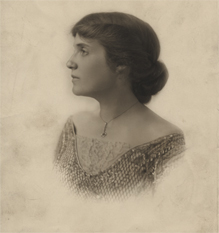 One can only wonder what sort of problems a beautiful young widow from the prairie might have encountered in the “big city.”
One can only wonder what sort of problems a beautiful young widow from the prairie might have encountered in the “big city.”
When she returned to Lincoln, she continued her concertizing and teaching at the Nebraska Conservatory. Again, a review describes her considerable talent. In the mean time, Mr. Movius had gone to Wesleyan to join its music faculty. Under his recommendation she was offered a position there as a voice teacher, and she was on that faculty for two years from 1908 to 1910. During that time she also toured extensively throughout the area with other faculty members. Examples of programs from the period include performances at the Shelby Opera House in 1908, the Kerr Opera House in 1909, and the Seward Opera House in 1910.
In 1910 Mr. Crancer, of Crancer Music Store in Lincoln, took Lillian to meet Willard Kimball who was the owner and director of the University School of Music. She was hired immediately and “began to teach in a little room at the top of the stairs.” Her teaching career at the University of Nebraska spanned the next twenty-eight years. When she joined the school, some of her fellow faculty members included Mortimer Wilson, Mrs. Will Owens Jones, Mr. and Mrs. Hagenow, Carrie Belle Raymond, Henry Eames, Howard Kirkpatrick, Charles Mills, Carl Steckelberg, and John Rosborough. These names read like a Who’s Who in Lincoln music history, and many of these individuals went on to national and international recognition. Lillian was in her element.
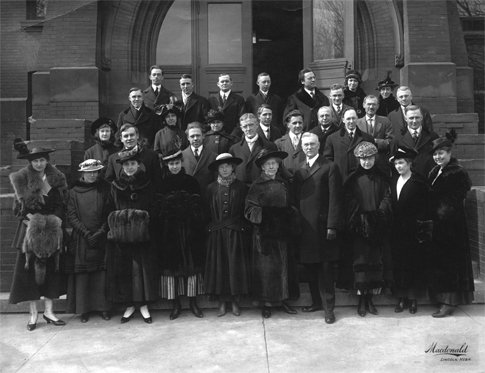
This is a photo of the University School of Music faculty taken in 1916. Back from L to R: 1. J. Frank Frysinger, organ 2. John Rosborough, theory 3. Phillip Hudson, piano 4. Staats, organ 5. Sidney Silber, piano 6. Marguerite Klinker, piano 7. Louise Zumwinkle-Watson, piano 1. Don Berry, trumpet and brass 2. George Kimball, office 1. Beth Bonnell Davis, voice 2. Vera Upton, voice 3.Connie Pettis, head of South Branch of School of Music 4. Charles Mills, voice 5. A. Loeb, strings 6. Morley, piano tuner 7. Everett Carter, treasurer 1. Carl Steckelburg, violin 2. Rex Fair, flute 3. John Prince, drama 4. Roger de Bouzon, voice 5. Howard Kirkpatrick, voice 6. Earnest Harrison, piano 1. Edith Pfesson, secretary 2. Kathryn Kimball, piano 3. Lula Karnes, voice 4. Ruth Bagnell, piano 5. Ruth Pilcher, piano 6. Mrs. Will Owen Jones, piano 7. William Kimball, director 8. M. Widener, piano 9. Lillian Polley, voice 10. Luna Schuler Smith, piano
Lillian’s teaching duties included both classes and private students. She taught Methods and Song Literature. She also continued a heavy performance schedule, appearing all over the mid-west as a soloist and for choral concerts at various colleges. She also began judging vocal contests. There is room here for only a very small selection of the programs from this period, but perhaps they will serve to indicate the breadth of her activities. They include programs entitled “Shakespeare and Music” 1911, “American Songs” 1912, and a performance at the Crete Opera House 1915.
For recitals like these she frequently appeared in costume. Here she is in her American Colonial dress.
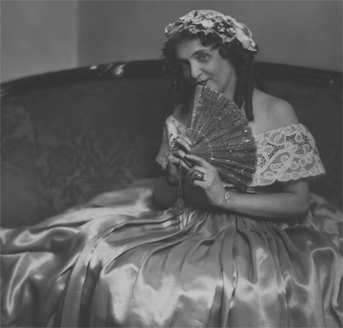
While her teaching and performing kept her busy during the regular school year, she found time to study with teachers in Europe in the intervening summer months. She worked with Alberto Randegger and Celine de Polkowski in London in 1909, and with Madame Arthur Nikisch in Germany that same year. In 1911 she was the private student of Madame Emma Albani who was the leading soprano at the Convent Garden Opera. Richard von Zur Muehlen accepted her as a student in 1913 at his home in Steyning, England. Also, in 1911 she acted as the European music correspondent for the Western Musical Herald of Kansas City.
In spite of all these activities, she seems to have had the time to be a normal young woman, at least once in a while. This picture from 1912 shows her at a New Year’s Eve social event with other young people her own age, including a young man named Ed Polley.
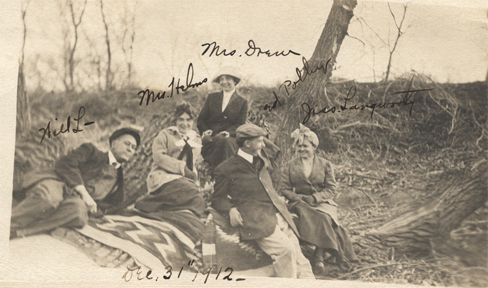
On June 29, 1914 Lillian married Edward Harrison Polley. Ed was born in Seward, Nebraska and was a pharmacist in Lincoln. He was also known as a “Good Roads” leader and acted as secretary for the association of the same name whose goal was to improve Nebraska highways. This is a picture taken in about 1917 of Lillian and Ed and Lillian’s mother, Cora Dobbs.
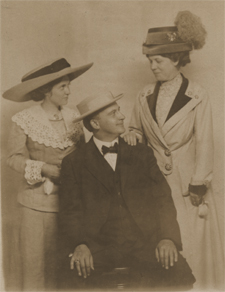
This second marriage did not seem to interfere as much with Lillian’s career, and she continued her teaching and singing. She was always interested in the mechanics of singing, and in 1918 she even managed to wangle her way into an anatomy class at the University, much to the dismay of the Registrar and the amusement of her fellow faculty members as seen in these two documents.
She was also free to study in Chicago in the summers between 1921 and 1932 with the nationally famous teachers Herbert Witherspoon and Oscar Saenger. These associations led to summer teaching positions at the Chicago Musical College for six years. Here are portraits taken of her during her Chicago years.
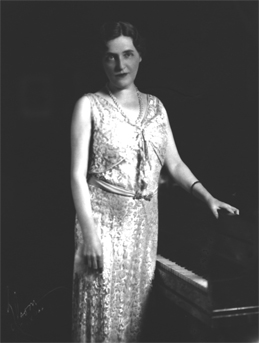
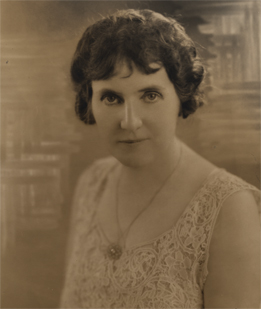
Lillian was an astute businesswoman, and she knew how to promote herself. Here is an advertising flyer she circulated in the late 1920s. It was a good thing that she used materials like these. In 1930 the University “bought” the School of Music from Willard Kimball. Lillian stayed on to teach but there were a lot of departmental political hassles. She gathered up a number of letters of recommendation from her teachers, colleagues, and students and presented them to the Chancellor’s office. Finally in 1932 she was made an “official” Professor of Voice as recorded in this letter from Howard Kirkpatrick, then director of the new University of Nebraska School of Music.
As she got older, she turned increasingly to her teaching activities and sang less and less in public. She had always been very interested in teaching young people to sing, and early on had founded the Youth Division of the Matinee Musicale organization in Lincoln. In the 1930s she began her work with very young children’s voices as part of a project assigned to her by the New York Singing Teachers’ Association, and gained national recognition for her work. A 1934 United Press article read:
“Mrs. Lillian Helms Polley of the University of Nebraska voice faculty believes that the time to teach youngsters how to sing is when they are just out of the cradle. Her voice-training class for children from 6 to 9 has been so successful that Mrs. Polley next year will open a class for four-year-olds.“
She received letters from parents and teachers all over the country who found her work intriguing and useful. She also lectured on the subject, and her notes for these talks have been preserved in the archive. Here are some of her thoughts:
“…children make greater demands on my knowledge and experience than adults. The younger the child the harder I work. When I began to work with children I was amazed to find the same problems that the adults labor over.”
“Voice production through singing is a tool for improved sociability, for health, happiness, and self-expression.”
“Good singing habits include many muscular skills and their rhythmic coordination plus the coordination between the mental and physical.”
“By the way, all the advantages claimed for athletics may also be credited to singing.”
“One of the strongest impressions I received during early periods of study with renowned teachers was the number of old students who were learning how to sing, how to use their voices, and how to break bad habits.”
“[We must] teach correct singing habits when the students are young so their later study can be devoted to the study of literature.”
“…there was a tradition which said the child must not be taught how to sing until two years past maturity, after the child has stopped growing. Be sure the voice is settled before accepting them for instruction.”
“In my judgment, the child’s first music teacher should be a singing teacher. But the singing teacher should be educated to be a music teacher….That early instruction is the most important of the child’s life and should be given by really competent people.”
“Public school teachers have limited [musical] training, limited time, and too many students”
“Public school music takes for its premise the human voice as the economical and practical medium or instrument with which to acquire a knowledge of music. Every child can afford a voice and he does not forget it or leave it out on the playground. And it is the only instrument which is continually adequate for the child at every age and size.”
“Even in the best of school systems with the best of teachers it seems to me the private singing teacher has a place [especially] in the care of the very talented child.”
Lillian lectured on other subjects as well, including such topics as “Music in the Home”, “Indian Lore in Song Literature”, “Music as a Profession for Women”, and “Group Singing.”
“I believe in music, and since music is essentially personal in its nature and object, it is native to that one place where we may be and usually are quite ourselves — our home!”
“When Mr. [Thurlow] Lieurance followed his best instincts he wrote closer to the Indian mode. But of course these did not meet as ready sale as the ‘Waters of Minnetonka’ and a composer must pay rent and buy clothes.”
“I think music is the nicest profession in the world although the financial returns are not alluring.”
“Whenever I see a group of people I always wish they would sing. I think singing has a contribution for almost any group activity.”
Another project of hers during this era was her singing group which she called her “Carolers”. It was made up of some of her young students and performed at various public locations and on a series of radio programs on station KFAB called “Around the Calendar with the Carolers.” Here she is on the subject of altered programming schedules:
“I knew the frustration of bowing to the inevitable clearing of the schedules to accommodate a ball game.“
In spite of such experiences Lillian enjoyed her association with the radio community in Lincoln and frequently acted as an announcer and writer of program notes for radio shows given by local faculty members and visiting artists.
In 1937 a “reorganization” of the music department was undertaken by the Board of Regents. Probably because of her age, her University position was again in jeopardy. She went into action and gathered up more letters of recommendation. In June of 1937 she received a letter from the Regents offering her an appointment for the 1937-1938 school year. The letter included this sentence: “You shall give no instruction in your subject off the University of Nebraska campus.” There are no written records of Lillian’s response to this dictum, but it should be noted that this was the last year she taught at the University.
Being more or less run out of the University certainly didn’t tarnish Lillian’s national reputation. In 1939 she was named to the publication Leading Women of America.
Her decision to retire from the faculty might also have been influenced by Ed’s declining health. She continued to teach at home so as to be near him. Here are pictures of an older Ed and their home on Woodsdale.
A newspaper article from 1940 reported of Ed, “When Mrs. Polley is teaching, he is the guardian of the ice chest, and lends lemons to questing neighbors.”
Ed died in 1948 after a long illness. Lillian’s response was, “Mr. Polley’s death in March, 1948, made travel important for the next three years.” She had been to Europe many times, so in 1950 she set out on a trip around the world which lasted for about four months. Her passport indicates visits to the Philippines, Hong Kong, Indochina, Japan, India, Egypt, Syria, Lebanon, Jordan, and Greece.
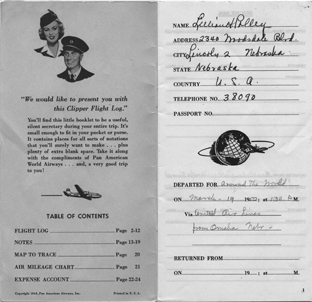
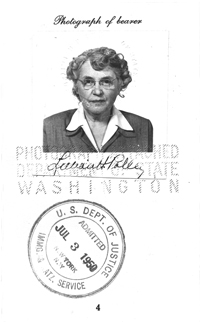
In 1951 Lillian added a new interest to her life. In March of that year the Lincoln Circlet Theatre needed a replacement for the part of the Dean of Women for their production of “Goodbye My Fancy.” She got the part, and then proceeded to do seven more productions. A 1954 newspaper article was entitled, “Circlet Actress Finds Play, Traveling Akin.”
“Doing a Circlet Community Theater play is something like flying around the world–at least it is ‘just like taking a trip,’ says Mrs. Lillian Helms Polley, singer turned dramatist….Mrs. Polley, who actually has flown around the world, likens acting to tripping because ‘when you prepare for a play you give up about six weeks. You lead an entirely different life, spend time with different people. It’s truly an enjoyable experience.‘”
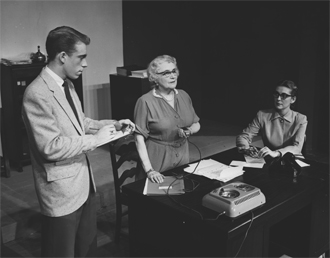
Production photo from “The Solid Gold Cadillac”
A partial list of plays she was in includes “The Curious Savage”, “The Heiress“, “The Silver Whistle“, “The Solid Gold Cadillac“, and “Goodbye My Fancy.”
She was a “natural” on stage because she could use her trained voice in the dramas. Over the years the Lincoln Community Theater awarded her three “Oscars” for Best Actress performances.
Lillian kept up her teaching during this time, but carried a much lighter load of students than she had in the past. Her last fine student was Diane Knotek [Butherus] who, as Miss Nebraska in 1956, won the Miss America Talent Award for her lovely singing.
Lillian’s high energy levels continued as she got older. She kept up her professional and civic affiliations with the Wooden Spoon, Nebraska State Music Teachers’ Association, Pi Kappa Lambda, Delta Omicron, the Lincoln Symphony Guild, Altrusa, P.E.O., and the Lotus Club. For the last group she wrote a history of the old University School of Music which was presented in 1967 and then published in the local newspaper in conjunction with Lincoln’s centennial celebration. Her archive includes the manuscript of that history.
The late 1960s also marked the beginning of Lillian’s last great project in Lincoln, our beloved Polley Music Library. She said she got the idea for a public music library way back in the 1930s. She had been concerned by what happened to the music that was being donated to the University of Nebraska at that time and was especially distressed when the library of Carrie Belle Raymond simple “evaporated” from the shelves. She became determined that her large collection of scores and books would not suffer the same fate.
In 1966 she gave the Lincoln City Libraries $12,000 to match a grant of Federal funds. The money was used to finance the building project which added the north and east wings to the two-story Bennett Martin Library and included a space that would become the Polley Music Library. She envisioned it as the beginning of a Performing Arts section in Bennett Martin Library. Her goal was to provide a place to house her collection and those of other contributors. It was to become a reference resource for students and teachers.
“People from the surrounding areas and schools could look to Lincoln for a broader knowledge of the literature of music.“
The local newspaper reported that the need for a public music library “seems urgent to a woman who believes music in life and life in music must never end in Lincoln, Nebraska.”
The building project was completed in late 1968, and in January of 1969 Lillian received an invitation to attend a preview open house. Then, with typical energy, she proceeded to catalog her collection and to gather up many other scores and books from her musician friends in Lincoln. Polley Music Library was alive and well.
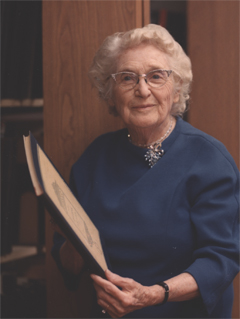
Lillian in the Polley Music Library
Her dream had come true, and her last years were spent caring for the music in her library. In addition, she left her estate in trust to the City of Lincoln and its citizens. In 1971 the Lincoln Star reported , “After her death the income from her estate will help maintain the music library. Mrs. Polley said, ‘That way I know the library will last. It’s my gift.'”
On March 5, 1973 Lillian Polley signed her will in which she left her estate to the Lincoln City Libraries. It reads in part:
“The net income from this trust fund shall be utilized for the creation, maintenance and improvement of a music room and music reference library at the Lincoln City Library, Lincoln, Nebraska, to be known as the Polley Music Reference Library.“
Lillian died March 24, 1978. Her funeral book was brought to the library by her cousin, Giles Henkle. Her remains are at Wyuka, but her spirit and legacy live on in our Polley Music Library. Indeed, her benevolence has benefited a far larger area than she had envisioned; this library has enriched the lives of people throughout the nation and the world. What a wonderful gift this woman gave us all!
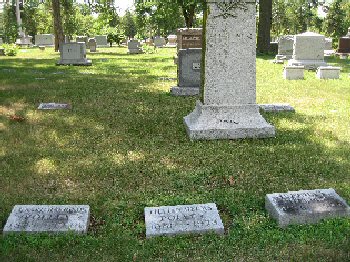
Photo by Scott Clark
Polley Music Library
- Monday, 11 August 2014 20:33
A Service of Lincoln City Libraries funded by the Lillian Helms Polley Trust
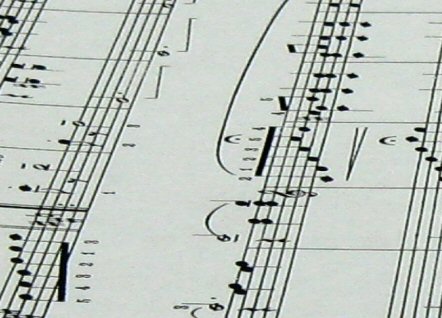 Welcome to the Polley Music Library, the public music library of Lincoln City Libraries, Lincoln, Nebraska, USA. The music library features a circulating collection of music books, printed music, and compact discs, along with digital collections, non-circulating reference materials, and music magazines. The Polley Music Library answers music-related questions, and provides other services, such as tours and programs.
Welcome to the Polley Music Library, the public music library of Lincoln City Libraries, Lincoln, Nebraska, USA. The music library features a circulating collection of music books, printed music, and compact discs, along with digital collections, non-circulating reference materials, and music magazines. The Polley Music Library answers music-related questions, and provides other services, such as tours and programs.
Polley Music Library Introduces Guitar Lending Program
Polley Music Library Hours
Tuesday, Wednesday, Friday and Saturday 2:00 – 6:00 p.m.
Thursday 3:00 – 7:00 p.m.
Visit us on the 2nd floor of Bennett Martin Public Library, 136 S. 14th Street, Lincoln, Nebraska. Polley Music Library materials are available for use when Bennett Martin Public Library is open.
Contact us by e-mail: polley@lincoln.ne.gov
Contact us by phone: 402-441-8520
Contact us by mail: Polley Music Library, Lincoln City Libraries, 136 S. 14 Street, Lincoln, NE 68508 USA


